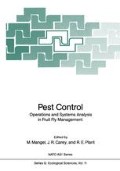Summary
Traps based on visual (color) and olfactory (food) attraction have been tested for monitoring or control purposes. The correlation between trap catches and population size or fruit infestation has been studied in certain cases. Lure combination often resulted in catches substantially higher than those of individual lures. Control applications have shown that even powerful, combined-lure traps must be applied at high densities for substantial infestation prevention. In years of very high population densities, even large numbers of such traps may not be adequate for effective control.
Further experimentation is needed to study the correlation between trap catches and actual population density at different seasons and weather conditions. Further work is also needed on the development of powerful traps which could keep infestation low at low cost. The effect of such traps on non-target insects should be explored carefully.
Access this chapter
Tax calculation will be finalised at checkout
Purchases are for personal use only
Preview
Unable to display preview. Download preview PDF.
References
Ballatori, E., CI. Pucci and C. Ricci. 1980. Relation entre l’infestation des olives et les captures d’adultes de Dacus oleae ( Gmel.) par pieges chromotropiques. Redia LXIII: 417–439.
Broumas, Th., P. Katsoyannos, C. Yamvrias, C. Liaropoulos, G. Haniotakis and F. Strong. 1983. Control of the olive fruit fly in a pest management trial in olive culture. Proc. Symp. on “Fruit Flies of Economic Importance” (Athens, Nov. 1982 ), A.A. Balkema/Rotterdam: 584–592.
Delrio, G. Biotechnical methods for olive pest control. Proc. Meeting EEC, FAO and IOBC on “Integrated Control in Oleiculture” (Pisa, April 1984): in press.
Delrio, G., A.P. Economopoulos, P.V. Economopoulos, G.E. Haniotakis and R. Prota (alphabetically). 1983. Comparative study on food, sex and visual attractants for the olive fruit fly. Proc. Symp. on “Fruit Flies of Economic Importance” (Athens, Nov. 1982 ), A.A. Balkema/Rotterdam: 465–472.
Economopoulos, A.P. 1979. Attraction of Dacus oleae (Gmelin) ( Diptera, Tephritidae) to odor and color traps. Z ang Ent. 88: 90–97.
Economopoulos, A.P. 1979. Application of color traps for Dacus oleae control: olive groves with different degree of isolation, tree-size and canopy density. Proc. Symp. IOBC/WPRS on “Integrated Control in Agriculture and Forestry” ( Vienna, Oct. 1979 ): 552–559.
Economopoulos, A.P. Use of traps based on color and/or shape. In, “Fruit Flies: Biology, Natural Enemies, Control” Eds. A. Robinson, G. Hooper, Elsevier Science Publishers: in press.
Economopoulos, A.P. and A. Stavropoulou-Delivoria. 1984. Yellow sticky rectangle with ammonium acetate slow-release dispenser: an efficient long-lasting trap for Dacus oleae Entomologia Hellenica 2: 17–23.
Economopoulos, A.P., A. Raptis, A. Stavropoulou-Delivoria and A. Papadopoulos. 198 6. Control of Dacus oleae by yellow sticky traps combined with ammonium acetate slow-release dispensers. Ent. exp. appl. 40: in press.
Kapatos, E. and B.S. Fletcher. 1983. Seasonal changes in the efficiency of McPhail traps and a model for estimating olive fly densities from trap catches using temperature data. Ent. exp. appl. 33: 20–26.
McPhail, M. 1937. Relation of time of day, temperature and evaporation to attractiveness of fermenting sugar solution to Mexican fruit fly. J. Econ. Entomol. 30: 793–799.
Neuenschwander, P. 1982. Beneficial insects caught by yellow traps used in mass-trapping of the olive fly, Dacus oleae Ent. exp. appl. 32: 286–296.
Prokopy, R.J. and A.P. Economopoulos. 1975. Attraction of laboratory-cultured and wild Dacus oleae flies to sticky- coated McPhail traps of different colors and odors. Environ. Entomol. 4: 187–192.
Prokopy, R.J., A.P. Economopoulos and M.W. McFadden. 1975. Attraction of wild and lab-cultured Dacus oleae flies to small rectangles of different hues, shades and tints. Ent. exp. appl. 18: 141–152.
Author information
Authors and Affiliations
Editor information
Editors and Affiliations
Rights and permissions
Copyright information
© 1986 Springer-Verlag Berlin Heidelberg
About this paper
Cite this paper
Economopoulos, A.P. (1986). Evaluation of Color and Food-Odor Trapping Methods in the Olive Fruit Fly. In: Mangel, M., Carey, J.R., Plant, R.E. (eds) Pest Control: Operations and Systems Analysis in Fruit Fly Management. NATO ASI Series, vol 11. Springer, Berlin, Heidelberg. https://doi.org/10.1007/978-3-642-70883-1_7
Download citation
DOI: https://doi.org/10.1007/978-3-642-70883-1_7
Publisher Name: Springer, Berlin, Heidelberg
Print ISBN: 978-3-642-70885-5
Online ISBN: 978-3-642-70883-1
eBook Packages: Springer Book Archive

